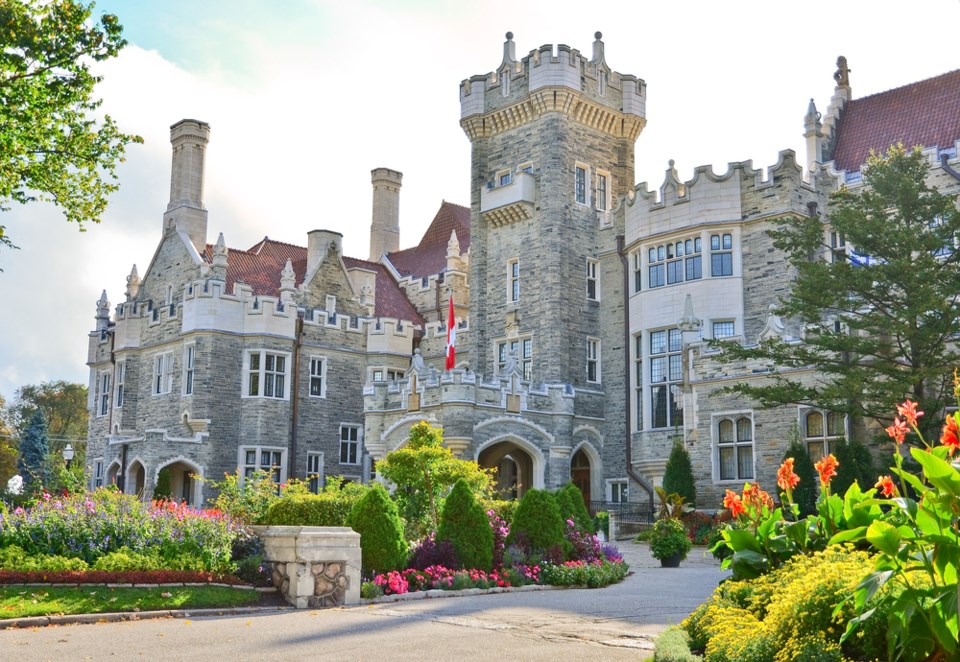Delve into the rich tapestry of hidden messages, secret passageways, and artwork to rival any museum, as you step back in time at Ontario’s historical castles.
Each landmark will transport you to an era gone by as you immerse yourself in the stories of the families that resided in these opulent estates.
From grand architecture to the sounds of the past, go back as far as the 1800s and prepare to be enchanted by timeless charm.
Casa Loma, Toronto
Canada’s most famous castle was built in 1914 by financier and philanthropist Sir Henry Pellatt, whose travels to Europe inspired his vision. Building Casa Loma took 300 men, almost three years, and $3.5 million.
However, due to effects of World War I and mounting taxes, Pellatt has no choice but to auction off his possessions and take up residence at his farm in King Township in 1924. From field trips to weddings to film and television shoots, every year this 200,000-square foot historical landmark welcomes over 650,000 visitors who continue to be enchanted by the 98 rooms, gardens, stables, and secret passageways.
Boldt Castle, Gananoque
Storybook castles and ancient shipwrecks make 1,000 Islands a tourist’s paradise, however it’s the tragic love story that just may be the most compelling part of the journey. Construction began in 1900 by George C. Boldt as a tribute to his wife. However, his darling Louise unexpectedly passed away just months before completion, and Boldt halted construction.
The castle remained vacant for 70 years. Since 1977, millions of dollars have been spent so the rooms could meticulously restored to look as authentic as they did 100 years ago. Tucked in among the St. Lawrence Rivers’ 1000 Islands, Boldt Castle is an Official Port of Entry into the United States in Alexandria Bay, New York and you will need your passport. The best way to access the castle is by booking a boat cruise tour.
Castle Kilbride, Baden
Modest by castle means, Castle Kilbride is certainly not the largest, but a stunning exterior matched by an equally exquisite interior has earned this home a place in the history books. Built in 1877 by James Livingston, “The Flax and Linseed Oil King of Canada,” Castle Kilbride served the family for three generations.
In 1988 the family sold the home, and furnishings went to the highest bidders at a four-day auction. After years of deterioration, the Town of Wilmot purchased the home, and in 1995 Castle Kilbride was declared a National Historic Site by the Historic Sites and Monument Board of Canada. When you visit, dedicate time to viewing the artwork. The illusionistic painting technique called “Trompe l'oeil”, a French term meaning “to fool the eye,” is employed in many of the decorative ceiling and wall paintings, revealing classic motifs and hidden images.
Fairmont Château Laurier, Ottawa
Next time you’re visiting the birthplace of the beaver tail, add this attraction to the “to do” list. Nestled between the Byward Market and Rideau Canal, lies the jewel in Ottawa’s crown, Fairmont Château Laurier. Constructed in 1912, this castle hotel has played host to royalty, dignitaries, and celebrities for over 100 years.
The chateau was designed in the Renaissance style with the neo-Gothic vertical lines to compliment the Parliament Buildings close by. Granite blocks, Italian marble and a copper roof are just a few of the features to allow this architectural masterpiece to endure.
Dundurn Castle, Hamilton
This 40-room Italianate-style villa was built in the 1830s, and is Ontario’s version of Downton Abby, telling the story of a railway magnate and his family who resided upstairs and the staff who resided down below. Dundurn Castle featured the latest conveniences of the day, including gas lighting and running water.
Formerly the site of a British military encampment during the war of 1812, visitors can expect a peaceful experience on a self-guided or guided tour of the restored Historic Kitchen Gardens. Don’t forget to pop into the 1870s Coach House turned The Castle Shop for some local crafts and treats. It’s a must.




